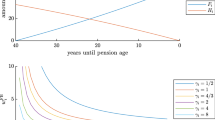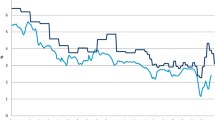Abstract
We study a model where the government offers two contracts: either low retirement age, low lifetime benefit or high retirement age, high lifetime benefit. Each worker privately knows whether he has a low or high life expectancy and chooses accordingly. The so-called ``actuarially fair'' system – calculated at an average life expectancy – is shown to be not fair: the expectedly shorter-lived subsidize the expectedly longer-lived. Considering optimal design, second-best contracts are separating. Under neutrality, the shorter-lived retire too early with too low a benefit. Under redistribution, the shorter-lived work long enough and receive a high enough benefit to enjoy a higher lifetime utility than under neutrality, although they subsidize the longer-lived.
Similar content being viewed by others
References
H. Cremer J-M. Lozachmeur P. Pestieau (2004) ArticleTitleSocial Security, Retirement Age and Optimal Income Taxation Journal of Public Economics 88 2259–2281 Occurrence Handle10.1016/j.jpubeco.2003.10.003
P. A. Diamond (2003) Taxation, Incomplete Markets and Social Security. Munich Lectures MIT Press Cambridge, MA
P. A. Diamond J. Mirrlees (1978) ArticleTitleA Model of Social Insurance with Variable Retirement Journal of Public Economics 10 295–336 Occurrence Handle10.1016/0047-2727(78)90050-6
Eső, P., and Simonovits, A. (2002): ``Designing Optimal Benefit Rules for Flexible Retirement.'' Discussion Paper CMS-EMS 1353, Northwestern University, Evanston, IL.
O. Fabel (1994) The Economics of Pensions and Variable Retirement Schemes Wiley New York
R. Fenge P. Pestieau (2005) Social Security and Early Retirement MIT Press Cambridge, MA
J. Gruber D. A. Wise (Eds) (1999) Social Security and Retirement Program Around the World Chicago University Press Chicago
Legros, F. (2003): ``Notional Defined Contribution: A Comparison of the French and the German Point Systems.'' World Bank Conference on NDC, Stockholm.
A. Lindbeck M. Persson (2003) ArticleTitleThe Gains from Pension Reform Journal of Economic Literature 41 74–112 Occurrence Handle10.1257/002205103321544701
J. A. Mirrlees (1971) ArticleTitleAn Exploration in the Theory of Optimum Income Taxation Review of Economic Studies 38 175–208 Occurrence Handle10.2307/2296779
M. Rothschild J. E. Stiglitz (1976) ArticleTitleEquilibrium in Competitive Insurance Markets: An Essay in the Economics of Imperfect Information Quarterly Journal of Economics 80 629–649 Occurrence Handle10.2307/1885326
A. Samwick (1998) ArticleTitleNew Evidence on Pensions, Social Security and the Timing of Retirement Journal of Public Economics 70 207–236 Occurrence Handle10.1016/S0047-2727(98)00022-X
E. Sheshinski (1978) ArticleTitleA Model of Social Security and Retirement Decisions Journal of Public Economics 10 337–360 Occurrence Handle10.1016/0047-2727(78)90051-8
Sheshinski, E. (2004): ``Optimal Delayed Retirement Credit''. CESifo Working Paper
A. Simonovits (2003) ArticleTitleDesigning Optimal Linear Rules for Flexible Retirement Journal of Pension Economics and Finance 2 273–293 Occurrence Handle10.1017/S147474720300132X
Simonovits, A. (2004): ``Designing Benefit Rules for Flexible Retirement: with or without Redistribution''. CESifo Working Paper 1370.
Simonovits, A. (2006): ``Optimal Design of Pension Rule with Flexible Retirement: The Two-type Case.'' Budapest, CEU Working Paper.
V. K. Smith D. H. Taylor F. A. Sloan (2001) ArticleTitleLongevity Expectations and Death: Can People Predict Their Own Demise? American Economic Review 91 1125–1134
S. Valdés-Prieto (2000) ArticleTitleThe Financial Stability of Notional Account Pensions Scandinavian Journal of Economics 102 395–417 Occurrence Handle10.1111/1467-9442.03205
Waldron, H. (2001): ``Links between Early Retirement and Mortality.'' ORES Working Paper 93, Division of Economic Research, SS Administration
Author information
Authors and Affiliations
Corresponding author
Rights and permissions
About this article
Cite this article
Simonovits, A. Optimal Design of Pension Rule with Flexible Retirement: The Two-Type Case. J Econ 89, 197–222 (2006). https://doi.org/10.1007/s00712-006-0196-4
Received:
Revised:
Published:
Issue Date:
DOI: https://doi.org/10.1007/s00712-006-0196-4




